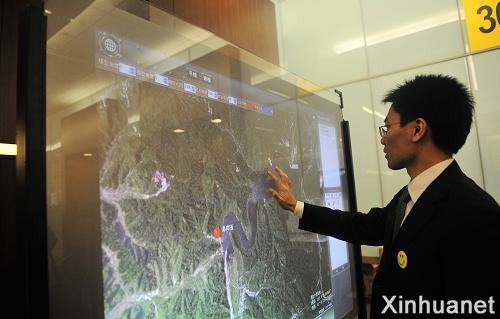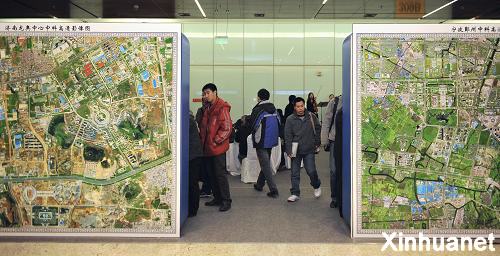|
CHINA SCIENCE AND TECHNOLOGY
NEWSLETTER
The Ministry of Science and Technology
People's Republic of China
|
|
|
N0.567 |
December 10, 2009 |
|
|
|
|
|
|
|
|
IN THIS ISSUE
|
|
*Peking University Collaborates with Pfizer
*3-D GIS System
*Human Pan-Genome Proposed
*Carbon Brake Disk for Large Aircraft
*Real-Time Precision GPS Technology
*Subsurface Buoy Deployed in Southern Ocean
*New DNA Sequencing System
|
|
INTERNATIONAL COOPERATION |
Peking University Collaborates with Pfizer
Not long ago, Peking University inked an accord with Pfizer to collaborate on life and biomedical sciences. According to the accord, Pfizer will finance the research projects of mutual interest, and help Peking University to establish a world-class biological transcription and new drug R&D center using its expertise in the area. The new drug R&D center under Peking University Shenzhen Graduate School will focus on the proprietary biomedical development, striving to apply basic research findings and clinical data in diseases diagnosis, prevention, and clinical interference. At present stage, the center will work on innovative therapies for treating cardiovascular, metabolism, and neurodegenerative diseases. The establishment of the new center will facilitate the development of biotechnology and pharmaceuticals in the southern part of China.
3-D GIS System

EV-Globe 2.0, a touch screen geographic information system.

CAS Institute of Remote Sensing Application, in collaboration with EarthView Image Inc. and National Remote Sensing Application Engineering Center, has recently rolled out an open 3-D air-earth-water information platform. EV-Globe 2.0, for its name, is designed with four major functions for secondary development, open spatial management, simulation interactions, and technical support. The platform, allowing information to flow between earth surface, air, water, and underground, makes a useful tool for numerous sectors.
The secondary development capability and SDK files makes the secondary development of a 3-D spatial information system no longer a difficult task. It takes a very short time for an average programmer to work out a powerful 3-D spatial information system. The open spatial management supports 3-D search, analysis, and regular GIS activities. In addition, the open simulation interaction function allows the combination of 3-D spatial information technology and special effect of simulation interactions. The built-in particle generator is able to bind the special particle effects with model components, desirable for dynamic modeling and skeleton animation. The open technical support module makes preamble codes available for adding new scalable functions.
Human Pan-Genome Proposed
Chinese scientists have landed a major progress in the area of human genome studies. They sorted out individual or population specific DNA sequences and functional genes. A human pan-genome concept has been proposed to explain the discovery. In the study, researchers sequenced and integrated the first Asian human genome, using the 2nd generation sequencing techniques and proprietary assembly tools. They found that human genomes are individual or population specific, in addition to the polymorphisms and structural mutations. Researchers also integrated de novo assembly of an Asian and an African genome with the NCBI reference human genome, and reached the same conclusions. Scientists believe that the integrated human genome map makes a human pan-genome. The finding was published in the recent issue of Nature Biotechnology.
Carbon Brake Disk for Large Aircraft
Xi’an Chaoma Technology has rolled out the proprietary carbon brake disk for large aircraft, marking a historical breakthrough in the area. Researchers have mastered a range of key technologies for manufacturing the proprietary carbon brake disk featured with high frictions and long work life. Enjoying an internationally advanced performance, the home made carbon brake disk has registered a reduced cost by 50%-60%, compared with similar products manufactured overseas. The home made disk will allow Chinese carriers to save an annual cost worth RMB 300 million. The Chinese made carbon brake disk has been so far granted with the manufacturing permit for some aircraft models, including Boeing 757 and Airbus 318/319/320, and was put into operation on the plateau flights, including the one to Lhasa.
Unmanned Mapping Aircraft
An unmanned mapping aircraft, jointly developed by Shandong Institute of Geological Survey and Mapping and Shandong S&T University, recently passed an approval check. Experts believe that the unmanned aircraft makes a powerful tool for resources survey and environment monitoring, thanks to its fast and real-time terrestrial observation and mapping capability and low air high resolution remote sensing data collected by the onboard high resolution digital remote sensing equipment. The aircraft is able to hit a precision of 1:2000-1:1000, using its low air photogrammetry capability. With the help of advanced image processing programs, the highly automated sensors have raised the precision of mapping, while reduced the workload of processing.
Real-Time Precision GPS Technology
An initiative to develop the wide area real-time precision GPS technology, under the terrestrial observation and navigation component of the National 863 Program for the 11th Five-year period (2006-2010), has rolled out a prototype system able to receive and process real-time satellite data, and generate and broadcast precision GPS products. The prototype has registered major technical indicators up to or exceeding the expected, with a real-time positioning precision better than 0.3m for the dual-frequency receiver, and better than 0.7m for the single-frequency receiver. As a follow up, researchers will work on the terminals for hand set, vehicle, and high precision applications, and increase the number of baseline stations with real-time access capability. The system, once completed, will produce China’s own enhanced satellite navigation signals, raising the real-time GPS precision from the current 4-20m to 0.2-0,8m. The improved system will find broad applications in the areas of precision agriculture, traffic and transportation, air traffic control, land resource survey, the Internet of things, and precision positioning service.
Subsurface Buoy Deployed in Southern Ocean

In its 26th journey to the pole, China Antarctic expedition team, deployed on December 6, 2009 an array of anchored subsurface buoys at a depth between 350m and 650m in the RYDZ BAY, some 60 sea miles away from Chinese Antarctic Zhongshan Station. As the first subsurface buoy based observation made by China in the Southern Ocean, the effort will lead to the evidences showing global climate change. Equipped with an array of observing equipment, including 1 ADCP, 1 TD, 1 sediment collector, 1 releaser, and 12 deep water floating glass balls, the current and temperature observation and sample collection will last for more than two months in a row. The subsurface buoys will be recovered by a Snow Dragon expedition boat in February 2010, when traveling to the point. Additionally, the onboard sediment collector will collect the samples of sediment particles transporting from the upper water body to the lower one, helping people to understand the production, output, and recycling of marine organic carbon in the pole, and providing meaningful evidences for understanding the impact of Southern Ocean carbon cycle variations on the carbon cycle at the lower and middle latitudes, and on the global carbon dioxide balance.
New DNA Sequencing System
Beijing Institute of Genomics, part of the Chinese Academy of Sciences, and Inspur established on December 3, 2009 a joint lab in Beijing to develop the home made 3rd generation DNA sequencing system. The prototype system will make its debut in 2013. According to a briefing, the new DNA sequencing system will be able to complete the human DNA sequencing in several dozen minutes, compared with the one-month sequencing cycle asked by its predecessor. Meanwhile, the cost will come down by some RMB 5000, or only 1% of the current cost. The joint lab will also work on the applications of bioinformatic algorithms under a new technological framework, and associated special bioinformatic systems.
Rice Species with Enhanced Tolerance
A novel high quality and high yield rice species featured with enhanced saline and alkaline tolerance has recently been proved a success in the west part of Jilin Province, an area notorious for its saline and alkaline soils. The improved species were derived from a range of efforts to breed out salt and alkali tolerant rice species using molecular markers and integrated growing techniques. As part of an initiative to develop improved rice germplasm resources for saline and alkaline soils, establishing the needed technical standards and species models, and developing applicable techniques for growing rice in the west part of Jilin Province, the project has so far completed saline and alkaline tolerance tests, and established demonstration plots, with a unit yield reaching 500kg/mu(1 mu= 0.0667 hectare). By 2011, the project will diffuse the growing techniques to more saline and alkaline areas soils, expecting a unit yield hitting 600-650kg/mu.
Novel HIV Mucosal Vaccine
Novel HIV mucosal vaccine, a major special project initiated by the central government in the 11th Five-year period (2006-2010), has recently achieved new progresses. Prof. ZHANG Linqi, Deputy Director of Tsinghua University HIV Research Center, told reporters that some 40 rhesus have been selected for the next phase experiment. The experiment will be extended to humans if rhesus based experiments call a success. Prof. ZHANG and coworkers found that the combined application of both MVTT and Ad5 is able to effectively curb the mucosal infection of SIVmac239 in rhesus. The immunity analysis of the rhesus vaccinated with MVTT and Ad5 shows that the combined solution induces a high-level cellular immune response sustained for an extended time in rhesus.
Exploring Interstellar Origin of Life
Chinese scientists are searching for interstellar molecular spectrum signals using a radio telescope in Delingha, the northern part of the Qinghai-Tibet Plateau, in an attempt to capture extraterrestrial information that may lead to the discovery of the interstellar origins of life. The 20-odd year observation and explorations has rewarded the researchers working there with a large collection of organic molecular spectrums. Researchers found that most of the 100 organic molecules observed can either be found or be synthesized on the earth, though a tiny amount of them do not exist on the earth.
Magnesium Battery
LI Hongbin, a research fellow at Xi’an Institute of Optics and Precision Mechanics, part of the Chinese Academy of Sciences, has successfully developed a proprietary novel battery: magnesium-based battery. The new power supply is able to work smoothly under extreme conditions, including 1,500m deep ocean floor and 40,000m upper air, making itself a desirable substitute for traditional zinc-manganese, lead-acid, and cadmium-nickel batteries. Expected to find broad applications in the area of industry and defense, the novel battery is of an enhanced low temperature endurance, safer performance, higher energy ratio, larger power discharge, and lower cost, compared with lithium batteries.
Visualized Mars Probe Process
China will launch its first Mars probe Yinghuo I via a Russian made launch vehicle in 2011. Not long ago, ZHAO Zhengxu, Dean of Computer and Information Engineering School, part of Shijiazhuang Railway Institute, told reporters that after the launch of the Mars probe, Beijing based command center will follow the entire probe process in a 3-D manner, based on the real-time data collected. The new system is designed to place a precise control over the operation of the probe, inputting the needed data to adjust the operation for a required scalability. It produces the visualized 3-D presentation of deep space probe activities on the known celestial bodies, including meteoroids, comets, and even space garbage.
Comments or inquiries on editorial matters or Newsletter content should be directed to:
Department of International Cooperation, MOST 15B, Fuxing Road, Beijing 100862, PR China Tel: (8610)58881360 Fax: (8610) 58881364
http://www.most.gov.cn |

